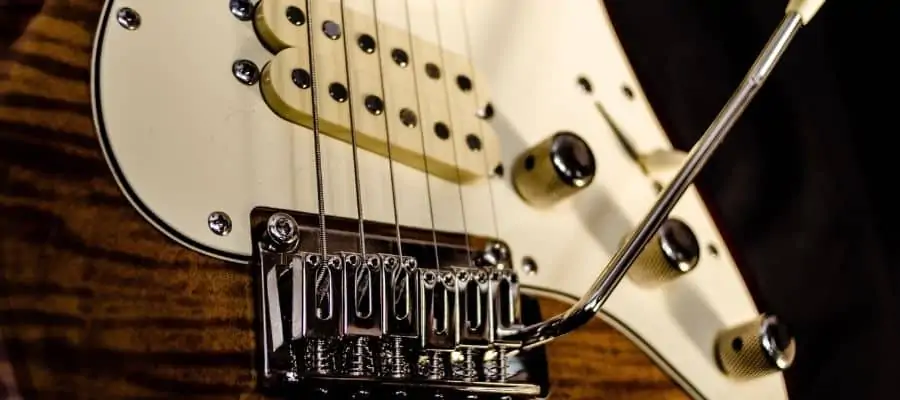As one of the pivotal inventions of the electric guitar, the whammy bar, or so-called tremolo bar, opens the realms of wide creative possibilities to guitarists. However, the whammy bar comes with advantages and disadvantages, making it slightly harder for beginner guitarists to manage through.
Whammy bars are ultimately a personal preference, and whether you need them or not depends on the style you want to play. A whammy bar is a must if you like expressive pitch manipulation, subtle vibrato, or dramatic dive-bombs, and if you’re going to play like Jimi Hendrix, Steve Vai, Hank Marvin, or Eddie Van Halen,
However, controlling the whammy bar can be challenging, and it can create tuning instabilities and lead to broken strings. To minimize those issues, you need a good tremolo system, preferably with a locking system, which can be more pricey. Remember that many guitarists play amazingly without the whammy bar use, too.
So, in the end, listen to both approaches carefully and decide which way you wanna go with it.
To make things a bit easier for you, I will dive deeper into the topic so you can explore more about whammy bars.
Advantages of Whammy Bars

The obvious advantage of whammy bars is the creative possibilities they bring to the table. From expressive pitch manipulation to subtle vibrato and Satriani-style diving effects, whammy bars can help you spice up your playing in various ways.
Shimmering Chords

With the tremolo bar, you can make your chords flare with subtle movements. You can strike the chord and gently use the whammy bar, depressing and releasing it quickly to add some ambient quality to your chords. This way, you can make your chords shimmer beautifully.
Extra Vibrato

When playing riffs, solos, or even rhythm sections, you can use the whammy bar to add some extra-dimensional vibrato to your playing. Of course, the natural vibrato done with fingers is the signature of a guitarist. However, you can spice up things with the whammy bar, creating either fast or slow, long or short vibratos.
Dive Bombs

This is where things get a bit more advanced and exciting. A dive bomb is an extreme pitch manipulation technique where you play a note or a chord and press the whammy bar all the way down toward the body of the guitar. This way, you can get that classic low-end pitch dive, which guitarists like Jimi Hendrix, Joe Satriani, and Eddie Van Halen, among many others, used frequently.
Also, you can go in the opposite direction with the so-called reverse dive-bomb technique. If you have a Floyd Rose bridge guitar, you can directly go the other way to a high-end pitch or if you have a Stratocaster-style bridge, you can start with the tremolo bar already pressed down and return to the natural pitch.
Dive bomb is a cool and relatively easy whammy bar technique, perfect for ending a song or a solo.
Others

There are many advanced tremolo bar techniques like The Scoop and Doop, The Elephant Noise, The Dime Squeal, Lizard Down The Throat, Hawaiian Chords, and Indian Grace Notes. You can check the video to hear some of them.
Imagine where Jimi Hendrix would be without his whammy bar, or would Hank Marvin be able to play those shimmering and amazing-sounding phrases without his tremolo bar? If you can use it well, a whammy bar is an excellent tool for expressive playing.
Disadvantages of Whammy Bars

The main disadvantage of whammy bars is that they make the guitar maintenance more challenging. Furthermore, it leads to tuning instabilities and maybe breaking of strings, especially with non-locking tremolo systems.
Tuning Instability
The most common issue with tremolo bars is that they create tuning instabilities with heavy use. Techniques like dive bombs and radical vibratos can put too much tension change on your strings, destabilizing the tuning, especially if you do not have a locking system.
That is why investing in a guitar with a locking tremolo system is well worth it if you are or want to be a heavy tremolo user.
String Breaking
Another less common but severe issue with whammy bars is that they can break the strings in heavy or wrong use. This is more of a problem for beginner guitarists as with proper guitar care and use, the strings won’t be easily broken, even with heavy tremolo bar use.
But another problem is that if you break a string on a guitar with a floating tremolo bridge, it is highly probable that all your strings will go out of tune, which actually takes us to the next issue.
Guitar Maintenance
Another disadvantage of tremolo bars is the difficulty of guitar maintenance. For instance, the string-changing process is more complicated, especially with systems like Floyd Rose, which has a locking tremolo system.
For instance, tuning and using alternative tunings gets quite challenging with locking tremolo systems, as you need wrenches to unlock the system and tune the strings. Also, everything is connected in systems like Floyd Rose, so if a string goes out of tune because of a bend or whammy bar use, everything is affected.
Less Sustain
The final disadvantage of whammy bars is the decreased sustain on the guitar tone. When the strings go directly into the body, it increases the guitar’s sustain as there is no dampening of the string vibration. That is why, for instance, Telecasters are always said to be more twangy and have more sustain compared to Stratocasters.
How do you decide if you need a Whammy Bar or not?

Ultimately, the question of having a whammy bar or not comes down to personal choice. Locking tremolo systems successfully keep you in tune with the frequent whammy bar use, but they are harder to maintain.
The Fender Strat bridge, on the other hand, does not allow for backward tremolo use, so it is more limited compared to the Floyd Rose systems. However, they are easier to maintain as they do not come with a locking system. But that also means less tuning stability.

In the end, you have to decide if you want to play heavily with the tremolo, or you will be a mild whammy bar user, or you do not care at all. If you are going to go heavy with the whammy bar, you should invest in a good locking tremolo Floyd Rose system. If you aim to be a mild tremolo bar user, a Strat Bridge without the locking system can be enough for you.
On the other hand, if you are not interested in using the whammy bar, you can go with a fixed bridge, which is easier to maintain and has increased sustain.
There are many great guitarists who use the whammy bar frequently, as well as ones who do not touch it at all. So, it is just a matter of preference.
Conclusion
Whammy bars are great tools to create out-of-this-world sounds from electric guitars, which can help guitarists unlock the doors of new creative possibilities. But, as discussed, they come with some disadvantages, which is why it is a delicate decision to invest in a good whammy bar system or not.
Depending on your playing style, goals, and likes, you may or may not take the road. Remember, a whammy bar won’t make you a great or bad guitarist. It is just a matter of taste! Listen to guitarists who use it frequently and who do not touch it at all so that you can decide which is your cup of cake.
If you found this article useful, you may want to save this pin below to your Guitar board.

Recent Posts
Some guitarists insist on buying an expensive amplifier with their electric guitar. They assume that this is a must for every type of guitarist out there. However, in some situations, this isn’t...
Top 50 Free Realistic Guitar VST Plugins With Sound Examples
As technology has rapidly advanced in the recent decade, computers are stealing more and more roles from physical musical instruments and accessories. Nowadays, you do not need expensive amps,...

